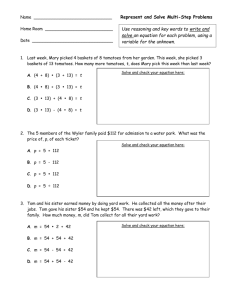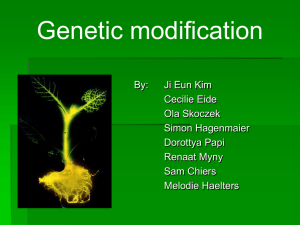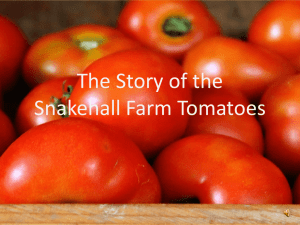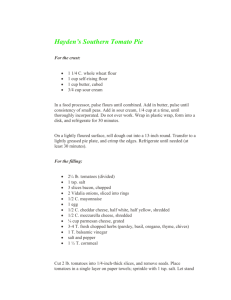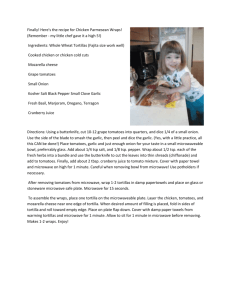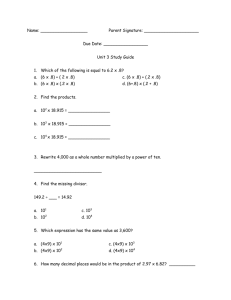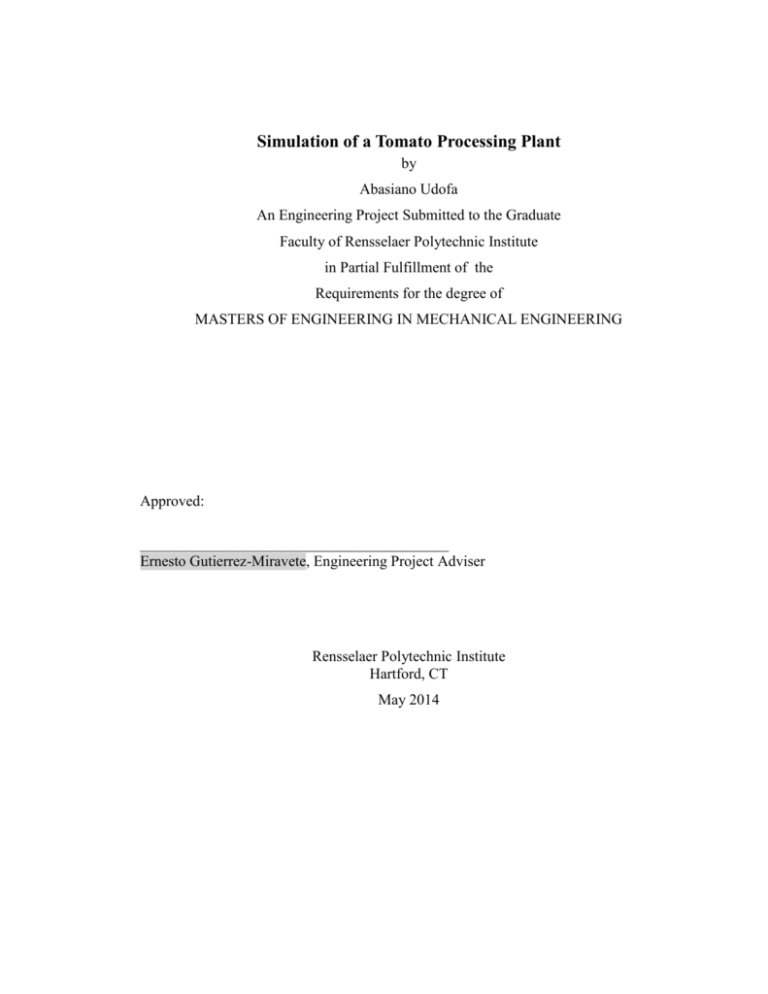
Simulation of a Tomato Processing Plant
by
Abasiano Udofa
An Engineering Project Submitted to the Graduate
Faculty of Rensselaer Polytechnic Institute
in Partial Fulfillment of the
Requirements for the degree of
MASTERS OF ENGINEERING IN MECHANICAL ENGINEERING
Approved:
_________________________________________
Ernesto Gutierrez-Miravete, Engineering Project Adviser
Rensselaer Polytechnic Institute
Hartford, CT
May 2014
© Copyright 2014
by
Abasiano Udofa
All Rights Reserved
ii
CONTENTS
Simulation of a Tomato Processing Plant ........................................................................... i
LIST OF FIGURES ........................................................................................................... v
ACKNOWLEDGEMENT ................................................................................................ vi
ABSTRACT .................................................................................................................... vii
1. Introduction.................................................................................................................. 1
1.1
Manufacturing Systems ...................................................................................... 1
1.2
Modeling Manufacturing Systems ..................................................................... 1
1.3
Discrete Event Simulation.................................................................................. 2
1.4
Tomato Processing Plant .................................................................................... 2
2. Methodology ................................................................................................................ 5
2.1
Mass Balance ..................................................................................................... 5
2.2
Deterministic vs. Stochastic Simulation ............................................................ 7
2.3
Hand Calculation and Queuing Model ............................................................... 8
3. Discrete Model Event ................................................................................................ 12
3.1
Assumptions ..................................................................................................... 12
3.2
Locations .......................................................................................................... 12
3.3
Entities and Arrivals ......................................................................................... 13
3.4
Processing and Routing .................................................................................... 13
4. Results........................................................................................................................ 15
4.1
Deterministic Runs ........................................................................................... 15
4.2
Stochastic Runs ................................................................................................ 18
4.3
Recommendations ............................................................................................ 24
4.4
Simulation vs. Hand Calculations .................................................................... 24
5. Conclusions................................................................................................................ 26
6. References.................................................................................................................. 27
7. Appendix.................................................................................................................... 33
iii
LIST OF TABLES
Table 2.1: Distribution Functions ...................................................................................... 8
Table 2.2: Deterministic hand calculation ......................................................................... 8
Table 2.3: Spreadsheet of Hand Calculations .................................................................. 11
Table 4.1: Location Statistics for deterministic0 ............................................................. 16
Table 4.2: Location Statistics for deterministic1 ............................................................. 16
Table 4.3: Location Statistics for stochastic1 .................................................................. 19
Table 4.4: Location Statistics for stochastic .................................................................... 19
Table 4.5: Location Statistics for stochastic10 ................................................................ 22
Table 4.6: Throughput times............................................................................................ 24
iv
LIST OF FIGURES
Figure 1.1: Layout of the Tomato Processing Plant .......................................................... 4
Figure 2.1: Mass Balance for Tomato Processing Plant .................................................... 6
Figure 3.1: Locations ....................................................................................................... 13
Figure 3.2: Processing and Routing ................................................................................. 14
Figure 4.1: Location Utilization for deterministic0 ......................................................... 17
Figure 4.2: Location Utilization for deterministic1 ......................................................... 17
Figure 4.3: Time Plot for Deterministic runs................................................................... 18
Figure 4.4: Location Utilization for Stochastic1 run ....................................................... 20
Figure 4.5: Location Utilization for Stochastic run ......................................................... 20
Figure 4.6: Time Plot for Stochastic1 run ....................................................................... 21
Figure 4.7: Time Plot for Stochastic run ......................................................................... 21
Figure 4.8: Location Utilization for Stochastic10 run ..................................................... 23
Figure 4.9: Time Plot for Stochastic10 run ..................................................................... 23
v
ACKNOWLEDGEMENT
I would like to first thank God for his grace and strength to study. I also want to thank
all of my teachers and professors I have had throughout my educational journey. A
particular note of thanks is given to my mother who had the idea of studying tomato
processing plants. I would also like to thank all of those who contributions to the field
of simulation I have used in this paper.
The books Modeling and Analysis of
Manufacturing Systems and Simulation Using ProModel provided an understanding of
manufacturing systems and the ProModel computer program. I would like to thank Dr.
Ernesto for his guidance through this process and his helpful insights on manufacturing
systems and ProModel. Lastly I would like to thank Dave Hoeppner for his assistance in
finishing this project.
vi
ABSTRACT
Tomato processing plants are large complex manufacturing systems that can often be
difficult to anticipate, plan, and react to the variability. Simulation is the imitation of a
dynamic system using a computer model. Simulation began to be used in commercial
applications in the 1960s. Now simulation is used by businesses to design, implement,
and optimize complex manufacturing and service systems. Simulation tools can be used
to gain further understanding of interdependencies and effects of variability on the
production of a tomato processing plant. This paper will discuss the development of a
simulation of a model of a tomato processing plant using Pro Model, a discrete event
simulation software.
The results of deterministic vs. stochastic simulation will be
discussed. The benefits of simulation vs. hand calculation method will be presented.
Recommendations for the most beneficial use of simulation software in the tomato
processing
industry
are
vii
presented.
1. Introduction
The purpose of this report is to demonstrate and discuss the modeling and analysis of a
tomato processing plant using the discrete event simulation program Pro Model. A brief
overview of manufacturing systems and how they are modeled computationally and
virtually will be given. A description of the tomato processing sequence of events will
be given for a better understanding of the system under study. The results of the
computer simulation will be compared with those obtained using simple hand
calculations.
1.1 Manufacturing Systems
Manufacturing systems are processing systems where raw materials are transformed into
finished products through a series of operations performed at workstations.
These
systems consist of entities, activities, resources, and controls that define the parameters
for processing. Entities are the items being processed through the system. Activities are
the tasks being performed in the system. Resources are what is being used to perform
the activities. Controls dictate when, where, and how the activities are performed. The
resulting interactions of these elements are what make manufacturing systems complex
and difficult to evaluate. Interdependencies and variability are the two factors that make
up the complexity of manufacturing systems and make the behavior difficult to analyze
and predict. The manufacturing system under study in this paper is a tomato processing
plant.
1.2 Modeling Manufacturing Systems
Hand computation and simulation are methods used to model manufacturing systems to
help understand the complexities and make responsible decisions. Hand computation
methods are extremely useful, but can be limited and inefficient with larger, more
complex systems. Simulation is a modeling and analysis technique used to evaluate and
improve dynamic systems of all types. Simulation is typically performed on a computer
utilizing various computer programs designed for capturing the behavior of specific
systems. Accurately predicting the performance of complex systems and having the
ability to test various scenarios before making major decisions that affect the system is
1
why simulation is important. Proper simulation accounts for interdependencies of a
system that cannot be obtained using other analysis techniques. This allows for risk-free
trial with no disruption to the current system and provides objective evidence to
substantiate changes to the system or guide in building a new system.
1.3 Discrete Event Simulation
How simulation works is dependent upon the method of simulation chosen.
The
common ways of characterizing simulation methods are static vs. dynamic, stochastic vs.
deterministic, and discrete event vs. continuous. Static simulation is one that is not timedependent while dynamic simulation is dependent on time. Dynamic simulations are
well suited for service and manufacturing systems.
Deterministic vs. stochastic
simulation has to do with the nature of the inputs and outputs. Deterministic simulation
has fixed inputs and outputs, while stochastic simulation has random inputs and outputs.
Deterministic simulation should always produce the same outcome no matter the number
of run times. Stochastic simulation requires several runs to get an accurate performance
estimate due to variations of outputs for a given run. Discrete-event simulation is based
on the tracking of events as they occur at distinct times during the simulation, while
continuous simulation is based on the tracking of events as they change continuously
with respect to time. Discrete-event simulations typically reflect many manufacturing
and service systems. The methods chosen for the simulations used for this project are
dynamic, discrete-event, both stochastic and deterministic.
These parameters best
represent tomato processing plants due to the change of state from solid tomatoes to
tomato paste. As shown in the following section tomato processing plants are processoriented systems, which are represented well by discrete-event simulation. Pro Model
was the software chosen to complete this simulation.
Pro Model is a powerful
commercial simulation tool designed to effectively model any discrete-event simulation
processing system.
1.4 Tomato Processing Plant
A tomato processing plant takes fresh tomatoes and turns them into paste by chopping,
heating, and removing the water from the tomatoes. Tomato processing plants are
2
complex manufacturing systems. The tomato paste manufacturing system is a process
layout known as a flow line. All the tomatoes move along the same sequence shown in
Figure 1.1.
The tomatoes are dumped into the receiving stations from the trucks
transporting them. The receiving station also includes 3 to 5 greater times the amount of
water then the weight of the tomatoes for cleaning purposes. The tomatoes are routed to
the washing/sorting station next. Having been washed under a clean water spray the
unfit tomatoes are picked out and sent to scrap while the rest of the tomatoes are sent to
the chopping station. At the chopping station the tomatoes are chopped by a hammer
chopper or a special mono-pump where they are broken and pulped. The pulp is preheated to 85-98°C for Hot Break processing. The pulp is then sent to the hot break
station consisting of a de-juicing unit (or juice extractors) composed of two centrifugal
stations: a pulper and a refiner, equipped with two sieves having different meshes. The
first sieve treats solid pieces up to 1 mm (or more), while the refiner processes solid
pieces up to 0.6 mm (or more). Two products therefore come out of the de-juicing unit:
refined juice ready for concentration and waste which is sent to scrap. The entire
concentration process (evaporation) takes place under vacuum conditions and at low
temperatures, significantly below 100°C. Product circulation inside the various
concentric tubular exchangers is carried out by special stainless steel pumps designed to
ensure that the product is conveyed inside the exchanger tubes at enough speed to avoid
“flash evaporation” (burning the tomato paste).
The concentrate is sent from the
evaporator directly inside the aseptic system tank where it is packaged.
3
Figure 1.1: Layout of the Tomato Processing Plant
4
2. Methodology
This section explains the methodology used for the hand calculations.
A
conservation of mass for the system is completed first. Given the arrival time of the
tomatoes and the assumed service rates of the locations the utilization rate, effective
arrival time, throughput time, and entities in the system are calculated. This information
will help to guide the building of the simulation. The hand calculations will be used as a
comparison to the outputs of the simulation.
2.1 Mass Balance
When building simulation models the first step is model conceptualization.
In
conceptualizing a tomato processing plant a mass balance is necessary to know how
entities are flowing through the plant. Although tomato processing plants change the
state of tomatoes to paste there still must be a conservation of mass. This model was
based on a plant that processes 1000 kg of tomatoes/day. This means 41.660 kg/hr are
being discharged into the system. One can assume that the tomatoes being discharged
were handpicked so we can expect ~2% waste between the receiving station and the
sorting station. The tomatoes next go to the chopping station then from the chopping
station to the hot break station. We can expect ~3% losses between the tomatoes going
from the hot break station to the evaporator. The evaporator station will evaporate ~84%
water at this station and the resulting paste will be sent to the aseptic filler. Figure 2.1
below
shows
a
breakdown
of
the
5
mass
balance
described
above.
Figure 2.1: Mass Balance for Tomato Processing Plant
6
2.2 Deterministic vs. Stochastic Simulation
Both deterministic and stochastic simulations have been used for the modeling of the
processing plant. Deterministic simulation contains no input components which are
random while stochastic simulation contains one or more input components which are
random. Due to this fact stochastic simulation produce outputs that are random and may
not be repeatable and deterministic simulation all future states are determined based on
the input data. Stochastic systems involve probability distributions to generate random
variables. A random variable is a function that assigns a value to every outcome of a
random experiment. The random variables for our purposes are continuous. The
continuous random variable X is defined by its probability density function f(x). The
probability that the continuous random variable X takes on a value in the interval [a,b] is
defined by equation 1 below.
𝑏
𝑃(𝑎 ≤ 𝑥 ≤ 𝑏) = ∫𝑎 𝑓(𝑥)𝑑𝑥
[1]
The exponential distribution is used for the arrival time of the tomatoes. The probability
density function is defined by equation 2 below.
𝑓(𝑥) = 𝜆𝑒 −𝜆𝑥
[2]
The exponential distribution is commonly used for inter-arrival times because the
preceding event does not affect the following event. It contains the “memoryless”
property. The normal distribution is used for the processing times the probability density
function is defined by equation 3 below.
1
1 𝑥−𝜇 2
)
𝜎
𝑓(𝑥) = 𝜎√2𝜋 𝑒 2(
[3]
Normal distributions are typical used for time waiting to perform a task or when many
different factors affect the outcome. The simulations scenarios ran will highlight further
the advantages and disadvantages of both types of simulation as it pertains to tomato
manufacturing plants. The distributions functions are built into Pro Model and generate
random variables based on the specified distribution.
distributions and Pro Model expressions.
7
Table 2.1 below shows the
Table 2.1: Distribution Functions
Distribution
Exponential
Normal
Pro Model
Expression
E(mean)
N(mean, std.
dev.)
2.3 Hand Calculation and Queuing Model
A hand calculation of a deterministic tomato processing plant with no waste is shown in
table 2.2. This was run to understand how the expected throughput time and the total
number of batches being processes in a 24 hour time period. The table shows that 1440
batches and a throughput time of 45 minutes.
Table 2.2: Deterministic hand calculation
Arrival quantity
(batches)
Inter-arrival
time (min)
Total time (hrs)
Total arrivals
(batches)
Process times
(min)
Receive
WashingSorting
Chopping
Hot Break
Evaporation
Total
10
10
24
1440
9
9
9
9
9
45
A queuing network consists of one or more locations which provide some service or
make arriving entities wait for service at a queue when locations are busy. Queuing
network theory is the basis for the calculations utilized to model the system. Queuing
networks provide good estimates for the characteristics addressed in simulation.
“Queuing theory is the science of waiting lines” (Harrell, 41). Understanding and
correctly utilizing the queuing networks was key to correctly building the hand
8
calculation and computer models for the tomato factory. In general the tomatoes arrival
and service rate are stochastic (as mentioned in section 1.3 stochastic arrivals involve
random inputs and outputs). Therefore to appropriately model the system random
numbers were used. Poisson arrivals, exponential distributions, and first come first serve
(FCFS) service provides the proper parameters for the hand calculations.
The
distributions of interarrival times are exponential. FCFS service has been assumed for
this type of system. The commonly used abbreviation for queuing systems has the form
A/B/s where “A” is the type of inter-arrival distribution, “B” is the type of service time
distribution, and “s” is the number of servers. The tomato processing plant uses M/M/1
queuing system for each workstation or process unit. The arrival rate is represented by
(the service rate is represented by. The utilization factor () equals the arrival
rate divided by the service rate.
𝜌 = 𝜆/𝜇
[4]
Calculations were also performed based on Little’s Law. Little’s law states the expected
number of entities in the system (L) is equal to the arrival rate (times the throughput
time (W).
𝐿 = 𝜆𝑊
[5]
where:
𝑊 = 1/𝜇(1 − 𝜌)
[6]
Open networks are systems consisting of multiple interconnected workstations typically
having jobs moving between pairs of stations according to some routing scheme. The
tomato processing plants consists of network workstations and was solved as an open
network. Open networks admit jobs from the outside world, which are then routed along
the network.
The following properties of stochastic systems are applicable to open networks.
1. The sum of independent Poisson RV is Poisson
2. If rates are Poisson inter-arrival times are Exponential
3. Inter-departure time from an infinite capacity M/M/c system is exponential.
9
The inter-arrival time (𝜆′) is defined by the arrival time multiplied by the probability of
the entity transferring to the next station (p).
𝜆′ = 𝜆𝑝
[7]
The three steps procedure used for analyzing this open queuing network are:
1. Determine effective arrival rates
2. Analyze each station as if it were alone
3. Aggregate the results over the network.
The expected throughput time is found by aggregating the results over the network.
𝑊 = 𝑊𝑗 𝜈𝑗
[8]
where:
𝜈𝑗 =
𝜆′
[9]
𝜆
A spreadsheet was created with the solutions of these steps and can be seen in table 1
below. Using open network theory for this tomato processing plant the throughput time
is 30.19 minutes. The calculations also give the utilization rate for each location below.
10
Table 2.3: Spreadsheet of Hand Calculations
Sorting Chopping
Hot
Break
Evaporating
Packaging
66.67
66.67
66.67
66.67
66.67
66.67
1.00
0.98
0.02
1.00
0.97
0.03
0.16
0.84
1.00
60.00
58.80
58.80
57.04
9.13
9.13
0.90
0.88
0.88
0.86
0.14
0.14
1.00
0.98
0.98
0.95
0.15
0.15
0.15
0.13
0.13
0.10
0.02
0.02
9.00
7.47
7.47
5.92
0.16
0.16
Receiving
Arrival
Quatinty
(batches)
Interarrival
time(min)
Service
times
(min)
10.00
10.00
9.00
Arrival Rate
(batches/hr)
Service
Rate
(batches/hr)
Probability
Scrap
Eff. Arrival
Rate
Utilization
Rate
Aggregate
Throughput
Rate
Expected
Throughput
Time (min)
60.00
*Please note 10 batches contains 600 tomatoes
11
30.19
3. Discrete Event Model
3.1 Assumptions
Several assumptions were made in the development of the simulation. The entities
arriving to the system are assumed to be in batches. The arrival rate is 10 batches per
minute. 1 batch contains 60 tomatoes, which means that there are 600 tomatoes/min. In
reality, there are multiple sorting stations and people monitoring and adjusting the
conveyor speeds for entrance into the plant. For this simulation there was only one
sorting station and the conveyors were given a speed of zero. These assumptions are
considered good assumptions because instead of a conveyor with speed queues were
utilized where you could hold the tomatoes until the next location is open. The service
times of the machines were assumed based on the desired per hour production output. In
reality there is more variability with the service times of the machines and the assumed
service times would be validated by data. Tomato processing plants use water and steam
as resources for processing. These resources were not added to this model to simplify
the model. There is an added location called scrap where all the waste is routed within
the system. In reality there are flow lines that will route the scrap out of the system. Pro
Model version 8 was used to model the system.
3.2 Locations
Figure 3.1 below shows the layout with all the locations. The queues, the receiving, and
the scrap locations have infinite capacity. The washing sorting, chopping, hot break,
evaporation, and packaging locations have capacities of 10 batches each.
12
Figure 3.1: Locations
3.3 Entities and Arrivals
The only entities in the system are tomatoes. The tomatoes arrival rate for the
deterministic runs is 10 batches/min. The inter-arrival time for the deterministic runs is
10 minutes and for the stochastic run is an exponential distribution with a mean of 10
minutes. Each batch contains 60 tomatoes.
3.4 Processing and Routing
The processing times for the deterministic runs are 9 minutes for every location except
for the queues, scrap, and packaging. The queues do not have a processing time and
entities are routed to exit from the scrap and packaging location. For the stochastic runs
with random service times, the processing times for every location is a normal
distribution with a mean of 9 minutes and a standard deviation of 1. The routing is
arranged for a serial flow through the system with a queue between every part of
contiguous locations. It is important to note that the routings account for the scrap
during processing through the probability command. From the receiving station to the
washing/sorting station, 100% of the entities were successfully processed. From the
washing/sorting to chopping station, 98% were successfully routed through the station
13
while the remaining 2% sent to scrap. From the chopping station the hot break station,
100% of the tomatoes were successfully routed through the system. From the hot break
to evaporation station 97% of the entities entering were routed while 3% were sent to
scrap. From evaporation to packaging station 16% are routed to be packaged while 84%
were sent to scrap. The 84% consists of all the water that is removed for the paste to be
made. Figure 3.2 shows the routing scheme in Pro Model.
Figure 3.2: Processing and Routing
14
4. Results
This section discusses the results obtained from the five simulations consisting of two
deterministic runs and three stochastic runs. For the deterministic runs the first one had
no scrap (deterministic0) and the other run had scrap (deterministic1). The first
stochastic run uses an exponential distribution for the arrival rate and no variability in
the processing times (stochastic1). The second stochastic run used an exponential
distribution for the arrival time and a normal distribution for the processing time of all
the locations except the queues (stochastic). The third stochastic run provided the
average of 10 replicated runs (stochastic10). The data for the locations utilization and
time plot tracking the arrival of the tomatoes will be discussed, as well as charts with
statistics. The section also includes recommendations on improvements in the simulation
of tomato processing plants. The discussion ends with a comparison of the simulated
resulted with the hand calculations. All of the simulation runs were done based on a
twenty four hour day.
4.1 Deterministic Runs
The scrap location in the simulation depicts where the waste is sent. The first
deterministic run (deterministic0) was simulated without any waste, knowing that this is
not how the plant functions in reality, to verify that the simulation was working properly.
The second deterministic run (deterministic1) has the correct waste allocations. Table
4.1 and 4.2 shows the location statistics for both runs. The results show that the
simulation is behaving as expected. In table 4.1 the total entries for scrap are 0 batches,
but in table 4.2 the total entries are 1195 batches. The total entries for all the other
locations and the percent utilization of the locations are affected between the two runs
because of changing the tomatoes being sent to scrap. Figure 4.1 and 4.2 show the same
effects of nothing being sent to scrap through the fluctuations in the percentage
utilization at each location for the deterministic0 and deterministic1 runs. The main
difference seen is that the chopping, hot break, and evaporation locations are occupied
approximately 2% and full 87% of the time in the deterministic0 run. This is contrasted
with being occupied 19% and full 70% of the time for chopping and hot break locations,
and occupied 36% and full 52% of the time at the evaporation location in the
15
determinstic1 run. This means that in the deterministic0 run more tomatoes are being
processed at these locations than in the deterministic1 run. This is consistent with
expectations as these are the locations with waste. Figure 4.3 shows a graph of the time
plot at the receiving location which verifies that the model is deterministic since there is
no change in the amount of time. The graph looks the same for both runs so only one
graph is show.
Table 4.1: Location Statistics for model deterministic0
Location
Receive
Washing
Sorting
Scrap
Chopping
Hot Break
Scheduled
Total
Average Time
Average Maximum Current
%
Time (Hr) Capacity
Entries
Per Entry (Min) Contents Contents Contents Utilization
24.00 999999.00 1450.00
8.94
9.00
10.00
10.00
0.00
Evaporation
Packaging
Queue1
Queue2
Queue3
Queue4
Queue5
24.00
24.00
24.00
24.00
10.00
10.00
10.00
10.00
1440.00
0.00
1430.00
1420.00
8.99
0.00
8.95
8.95
8.99
0.00
8.89
8.82
10.00
0.00
10.00
10.00
10.00
0.00
10.00
10.00
89.94
0.00
88.86
88.24
24.00
24.00
24.00
24.00
24.00
24.00
24.00
10.00
10.00
999999.00
999999.00
999999.00
999999.00
999999.00
1410.00
1400.00
1440.00
1430.00
1420.00
1410.00
1400.00
8.95
0.00
0.00
0.42
0.81
1.22
1.15
8.76
0.00
0.00
0.42
0.80
1.19
1.12
10.00
1.00
10.00
10.00
10.00
10.00
10.00
10.00
0.00
0.00
0.00
0.00
0.00
0.00
87.60
0.00
0.00
1.13
1.13
1.13
1.12
Table 4.2: Location Statistics for model deterministic1
Location
Receive
Washing Sorting
Scrap
Chopping
Hot Break
Evaporation
Packaging
Queue1
Queue2
Queue3
Queue4
Queue5
Scheduled
Time (Hr)
24.00
24.00
24.00
24.00
24.00
24.00
24.00
24.00
24.00
24.00
24.00
24.00
Capacity
999999.00
10.00
10.00
10.00
10.00
10.00
10.00
999999.00
999999.00
999999.00
999999.00
999999.00
Average Time
Total
Per Entry
Average Maximum Current
%
Entries
(Min)
Contents Contents Contents Utilization
1450.00
8.94
9.00
10.00
10.00
0.00
1440.00
8.99
8.99
10.00
10.00
89.91
1195.00
0.00
0.00
1.00
0.00
0.00
1399.00
8.95
8.70
10.00
9.00
86.97
1390.00
8.95
8.64
10.00
10.00
86.37
1341.00
8.94
8.33
10.00
10.00
83.29
206.00
0.00
0.00
1.00
0.00
0.00
1440.00
0.00
0.00
10.00
0.00
0.00
1399.00
0.42
0.41
10.00
0.00
1.10
1390.00
0.81
0.79
10.00
0.00
1.11
1341.00
1.22
1.14
10.00
0.00
1.08
206.00
1.15
0.16
5.00
0.00
0.17
16
Figure 4.1: Location Utilization for deterministic0
Figure 4.2: Location Utilization for deterministic1
17
Figure 4.3: Time Plot for Deterministic runs
4.2 Stochastic Runs
Stochasticity simulated the randomness that many manufacturing plants experience. The
first stochastic run (stochastic1) uses an exponential distribution with mean of 10
minutes for an inter-arrival time and the same deterministic processing times as the two
deterministic runs. The second stochastic run (stochastic) uses the same distribution for
the inter-arrival time and normal distributions for the processing times. The location
statistics for both of the scenarios are in table 4.3 and 4.4 respectively.
Adding
randomness to the inter-arrival time reduced the total batches of tomatoes at the
receiving location to 1290 from the 1450 seen in table 4.2 for the deterministic1 run.
However, table 4.4 for the stochastic run has the most entries to the receiving location of
1630 batches. This difference is due to the exponential distribution. The tables also show
an increase in the percent utilization for the stochastic vs. stochastic1 run. The average
time per entry is about the same for both runs except for at queue1. It is 10.74 minutes
for the stochastic1 run vs. 60.53 minutes for the stochastic run. The difference in the
amount of batches the plant is seeing accounts for the change to the average time per
entry for queue1. Figure 4.4 and 4.5 shows a breakdown of what is happening at each
18
location in terms of percent of the time empty, occupied, or full for the stochastic1 and
stochastic run respectively. The washing-sorting, chopping, hot break and evaporation
locations are full approximately 30% more in the stochastic run vs. stochastic1 run. This
can be attributed to the fact that the stochastic run has more batches in the system.
Hourly time plots for the receiving locations for the stochastic1 and stochastic runs are
shown in figure 4.6 and 4.7 respectively. The graph shows there are more batches being
process for the stochastic run because the range slightly greater than 18, while for the
stochastic1 run it is 12. Unlike the deterministic run in figure 4.3 these figures are not a
constant value.
Table 4.3: Location Statistics for stochastic1
Scheduled
Locations
Time (Hr)
Receive
24.00
Washing Sorting
24.00
Scrap
24.00
Chopping
24.00
Hot Break
24.00
Evaporation
24.00
Packaging
24.00
Queue1
24.00
Queue2
24.00
Queue3
24.00
Queue4
24.00
Queue5
24.00
Total
Capacity Entries
999999.00 1290.00
10.00 1290.00
10.00 1100.00
10.00 1249.00
10.00 1249.00
10.00 1208.00
10.00
168.00
999999.00 1290.00
999999.00 1249.00
999999.00 1249.00
999999.00 1208.00
999999.00
170.00
Average
Time Per
Entry
Average Maximum Current
%
(Min)
Contents Contents Contents Utilization
9.00
8.06
50.00
0.00
0.00
8.99
8.05
10.00
10.00
80.51
0.00
0.00
1.00
0.00
0.00
9.00
7.81
10.00
0.00
78.06
8.95
7.76
10.00
10.00
77.62
9.00
7.55
10.00
0.00
75.50
0.00
0.00
1.00
0.00
0.00
10.74
9.62
40.00
0.00
0.00
0.42
0.37
10.00
0.00
0.98
0.81
0.71
10.00
0.00
1.00
1.22
1.02
10.00
0.00
0.97
1.14
0.13
5.00
2.00
0.14
Table 4.4: Location Statistics for stochastic
Scheduled
Locations
Time (Hr)
Receive
24.00
Washing Sorting
24.00
Scrap
24.00
Chopping
24.00
Hot Break
24.00
Evaporation
24.00
Packaging
24.00
Queue1
24.00
Queue2
24.00
Queue3
24.00
Queue4
24.00
Queue5
24.00
Total
Capacity Entries
999999.00 1630.00
10.00 1572.00
10.00 1291.00
10.00 1534.00
10.00 1521.00
10.00 1470.00
10.00
235.00
999999.00 1620.00
999999.00 1534.00
999999.00 1524.00
999999.00 1474.00
999999.00
235.00
Average
Time Per
Entry
Average Maximum Current
%
(Min)
Contents Contents Contents Utilization
8.94
10.12
60.00
10.00
0.00
8.93
9.75
10.00
10.00
97.46
0.00
0.00
1.00
0.00
0.00
8.96
9.54
10.00
10.00
95.40
8.97
9.47
10.00
9.00
94.70
9.04
9.23
10.00
10.00
92.26
0.00
0.00
1.00
0.00
0.00
60.53
68.09
147.00
48.00
0.01
1.57
1.68
8.00
0.00
4.49
1.99
2.11
8.00
3.00
2.98
1.84
1.88
7.00
4.00
1.78
1.15
0.19
3.00
0.00
0.19
19
Figure 4.4: Location Utilization for Stochastic1 run
Figure 4.5: Location Utilization for Stochastic run
20
Figure 4.6: Time Plot for Stochastic1 run
Figure 4.7: Time Plot for Stochastic run
The final stochastic run (stochastic10) is the average results of 10 runs with the same
distribution functions as the stochastic run. In reality the processing times and interarrival times will be random so this is very useful data since every stochastic run
produces different random numbers. Table 4.5 shows the location statistics which reports
the total entries to the receiving location at 1485 batches. This is lower than the
stochastic run but higher than the stochastic1 run. The 1485 batches are slightly greater
21
than the average of the prior runs. This number would probably be closer to actual
figures. The percent utilization is down from the stochastic run also. The same trend
continues when looking at the location utilization chart figure 4.8. The numbers are in
the middle of the previous two runs as far as percent full and occupied. The hourly time
plot figure 4.9 shows the randomness at the receiving location and is different than both
the prior runs. Table 4.6 shows the total number of batches that exited the plant in the 24
hour period that it was run and the throughput time. The two deterministic runs differ by
1 batch, while with the stochastic runs there is greater variability. The throughput times
for the deterministic and stochastic runs are between 46-49 minutes. This shows that
even with the randomness the throughput times are generally consistent. Introducing
stochasticity is closer to the reality of how a real plant would function. The different
simulated scenarios and statistics provide valuable insight on how to modify a plant for
optimum output.
Table 4.5: Location Statistics for stochastic10
Scheduled
Name
Time (Hr)
Receive
24.00
Washing Sorting
24.00
Scrap
24.00
Chopping
24.00
Hot Break
24.00
Evaporation
24.00
Packaging
24.00
Queue1
24.00
Queue2
24.00
Queue3
24.00
Queue4
24.00
Queue5
24.00
Total
Capacity Entries
999999.00 1485.00
10.00 1441.10
10.00 1182.70
10.00 1403.60
10.00 1393.20
10.00 1340.00
10.00
216.20
999999.00 1478.00
999999.00 1404.20
999999.00 1394.90
999999.00 1342.00
999999.00
216.30
Average
Time Per
Entry
Average Maximum Current
%
(Min)
Contents Contents Contents Utilization
8.96
9.24
51.90
7.00
0.00
8.95
8.96
10.00
9.80
89.58
0.00
0.00
1.00
0.00
0.00
8.97
8.75
10.00
8.70
87.46
8.97
8.68
10.00
9.90
86.84
8.97
8.35
10.00
9.40
83.46
0.00
0.00
1.00
0.00
0.00
34.87
36.89
109.80
36.90
0.00
1.34
1.33
7.10
0.60
3.55
1.66
1.62
7.20
1.70
2.29
1.59
1.49
6.80
2.00
1.41
1.15
0.17
3.20
0.10
0.17
22
Figure 4.8: Location Utilization for Stochastic10 run
Figure 4.9: Time Plot for Stochastic10 run
23
Table 4.6: Throughput times
Run
Deterministic0
Deterministic1
Stochastic1
Stochastic
Stochastic10
Average Time
Total Exits In Operation
(Min)
1400.00
1401.00
1268.00
1526.00
1398.90
48.61
46.69
46.64
48.30
47.68
4.3 Recommendations
The simulation of a tomato processing plant can be further refined to provide the
maximum benefit to the industry. Any tomato processing plant looking to use simulation
should take statistics of their specific plant to minimize uncertainty from assumptions.
Statistics should be taken for the arrival rate of tomatoes to the plant, the processing
times at each location, and the inter-arrival times of the tomatoes. The statistics can then
be fitted to the most accurate distribution function and whether deterministic or
stochastic simulation should be done. The importance of this has been seen in section 4.1
and 4.2 as the results differ based on assumptions and distribution functions chosen.
Information about the amount and flow of resources can also be added to the simulation
to determine the effects on production. Resources needed for a tomato processing plant
are water, steam, and power.
4.4 Simulation vs. Hand Calculations
The deterministic and open network queuing theory hand calculations performed in
section 2.3 provided some helpful insight but the Pro Model simulation would be the
preferred method due to the complexity of this system. Pro Model simulation allows for
good decision in the shortest time possible.
The hand calculations predicted the
utilization rate for each location but the Pro Model simulation showed the rate of
utilization as well as how it was being utilized empty, full, or occupied. The built in
distribution functions allowed for quick changes and evaluations on the effects which
would not be possible with the hand calculations. The ability to model queues in the
simulation is insight that the hand calculations would not be able to depict accurately.
The throughput time and entities in the system for the deterministic simulations and the
24
deterministic hand calculations are very close. The hand calculations shows entities in
the system at 1440 batches while the Pro Model runs show at the receiving location 1450
batches entered the system. The throughput time for the deterministic hand calculation
was 45 minutes and for the Pro Model deterministic it was 48.61 and 46.69 minutes. The
queuing theory had the throughput time at 30.19 minutes which was off from what Pro
Model shows. The percent utilization for the washing-sorting, chopping, and hot break
for the queuing theory is within 1% of the Pro Model numbers of the deterministic runs.
The hand calculations are good in providing rough solutions but would fail to provide
the accurate solutions needed for a dynamic system such as the tomato processing plant.
25
5. Conclusions
Discrete event simulation is valuable and should be utilized in the tomato processing
industry. Discrete event simulation accurately converted the activities performed in a
tomato processing plant to time triggered events and consequent reactions which were
chronologically processed. With the many uncertainties that arise from variability and
interdependencies of a tomato processing plant, simulation can be used for production
planning, scheduling, and guide decision to increase productivity. Discrete event
simulation shows the effects on process parameters when modeling manufacturing
systems. These parameters are static vs. dynamic, stochastic vs. deterministic, and
discrete event vs. continuous. Tables 4.1-4.2 along with figures 4.1-4.3 showed the
results for deterministic Pro Model runs and the effect of adding waste to the model.
The effects of adding stochasticity can be seen in table 4.3-4.4 and figures 4.4-4.6. Table
4.5 and figures 4.7-4.9 show the benefits of replications on predicting results. Collecting
data statistics about the processing plant and converting that into the proper distribution
functions is important to accurately capture the system dynamics. Simulation is the
preferred method rather than hand calculation for complex systems such as tomato
processing plants. Although performing hand calculations may be initially cheaper the
potential benefits of simulation can have more financial pay offs for companies than
hand calculations.
26
6. References
1. Askin, Ronald and Charles Standridge. Modeling and Analysis of Manufacturing
Systems. New York: John Wiley & Sons, Inc., 1993. Print
2. Harrell, Charles, Biman K. Ghosh, and Royce O. Bowden Jr. Simulation Using
Promodel. New York: McGraw-Hill, 2004. Print
3. Gutierrez-Miravete, Ernesto. [Online] 18, January, 2001. [Cited: 5, November, 2013]
http://www.ewp.rpi.edu/hartford/~ernesto/C_S2001/mams/notes/mams02.html
4. Gutierrez-Miravete, Ernesto. [Online] 26, September, 2002. [Cited: 23, October
2013]
http://www.ewp.rpi.edu/hartford/~ernesto/C_F2002/DES/Notes/s04/s04.pdf
5. Fenco Food Machinery. [Online] [Cited: 25, April, 2013]
http://www.fenco.it/eng/tomato-paste-processing.asp
6. Whitney, Daniel E. [Online] 20, November, 2002. [Cited: 16, December 2013]
http://ocw.mit.edu/courses/mechanical-engineering/2-875-mechanical-assemblyand-its-role-in-product-development-fall-2004/lecture-notes/cls20_smltion04.pdf
27
********************************************************************************
*
*
*
*
*
*
*
*
Formatted Listing of Model:
C:\Users\udofaa\Downloads\deterministic0.MOD
********************************************************************************
Time Units:
Distance Units:
Minutes
Feet
********************************************************************************
*
Locations
*
********************************************************************************
Name
Cap
Units Stats
Rules
Cost
--------------- -------- ----- ----------- -------------- -----------Receive
Washing_Sorting
Scrap
Chopping
Infinite
10
10
10
1
1
1
1
Hot_Break
10
1
Time Series Oldest, FIFO,
Evaporation
Packaging
Queue1
10
1
10
1
INFINITE 1
Time Series Oldest, FIFO,
Time Series Oldest, FIFO,
Time Series Oldest, FIFO,
Queue2
Queue3
Queue4
Queue5
INFINITE
INFINITE
INFINITE
INFINITE
Time
Time
Time
Time
1
1
1
1
Time
Time
Time
Time
Series
Series
Series
Series
Series
Series
Series
Series
Oldest,
Oldest,
Oldest,
Oldest,
FIFO,
,
,
FIFO,
Oldest,
Oldest,
Oldest,
Oldest,
FIFO,
FIFO,
FIFO,
FIFO,
********************************************************************************
*
Entities
*
********************************************************************************
Name
Speed (fpm) Stats
Cost
---------- ------------ ----------- -----------tomatoes
150
Time Series
********************************************************************************
*
Processing
*
********************************************************************************
Process
Routing
Entity
Location
Operation
-------- --------------- ------------------
Blk Output
Destination
Rule
---- -------- --------------- ----------
tomatoes
tomatoes
tomatoes
tomatoes
1
1
1
tomatoes Queue1
FIRST 1
tomatoes Washing_Sorting FIRST 1
tomatoes EXIT
FIRST 1
tomatoes
tomatoes
tomatoes
tomatoes
tomatoes
tomatoes
Queue3
Queue4
Scrap
Queue5
Scrap
EXIT
FIRST 1
1.000000 1
0.000000
1.000000 1
0.000000
FIRST 1
Queue2
Scrap
Hot_Break
Chopping
1.000000 1
0.000000
FIRST 1
FIRST 1
Receive
Queue1
Scrap
Chopping
Wait 9
Wait 9
tomatoes Hot_Break
Wait 9
1
1
tomatoes Evaporation
Wait 9
1
tomatoes Packaging
1
tomatoes Washing_Sorting Wait 9
1
tomatoes Queue3
tomatoes Queue2
1
1
tomatoes
tomatoes
tomatoes
tomatoes
tomatoes Queue4
tomatoes Queue5
1
1
tomatoes Evaporation
tomatoes Packaging
FIRST 1
FIRST 1
********************************************************************************
*
Arrivals
*
********************************************************************************
Entity
Location Qty Each
First Time Occurrences Frequency Logic
-------- -------- ---------- ---------- ----------- ---------- -----------tomatoes Receive 10
0
INF
10 min
28
Move Logic
------------
********************************************************************************
*
*
*
*
*
*
*
*
Formatted Listing of Model:
C:\Users\udofaa\Downloads\deterministic1.MOD
********************************************************************************
Time Units:
Distance Units:
Minutes
Feet
********************************************************************************
*
Locations
*
********************************************************************************
Name
Cap
Units Stats
Rules
Cost
--------------- -------- ----- ----------- -------------- -----------Receive
Washing_Sorting
Scrap
Chopping
Infinite
10
10
10
1
1
1
1
Time
Time
Time
Time
Hot_Break
10
1
Time Series Oldest, FIFO,
Evaporation
Packaging
Queue1
10
1
10
1
INFINITE 1
Time Series Oldest, FIFO,
Time Series Oldest, FIFO,
Time Series Oldest, FIFO,
Queue2
Queue3
Queue4
Queue5
INFINITE
INFINITE
INFINITE
INFINITE
Time
Time
Time
Time
1
1
1
1
Series
Series
Series
Series
Series
Series
Series
Series
Oldest,
Oldest,
Oldest,
Oldest,
Oldest,
Oldest,
Oldest,
Oldest,
FIFO,
,
,
FIFO,
FIFO,
FIFO,
FIFO,
FIFO,
********************************************************************************
*
Entities
*
********************************************************************************
Name
Speed (fpm) Stats
Cost
---------- ------------ ----------- -----------tomatoes
150
Time Series
********************************************************************************
*
Processing
*
********************************************************************************
Process
Routing
Entity
Location
Operation
-------- --------------- ------------------
Blk Output
Destination
Rule
---- -------- --------------- ----------
tomatoes
tomatoes
tomatoes
tomatoes
1
1
1
tomatoes Queue1
FIRST 1
tomatoes Washing_Sorting FIRST 1
tomatoes EXIT
FIRST 1
tomatoes
tomatoes
tomatoes
tomatoes
tomatoes
tomatoes
Queue3
Queue4
Scrap
Queue5
Scrap
EXIT
FIRST 1
0.970000 1
0.030000
0.160000 1
0.840000
FIRST 1
Queue2
Scrap
Hot_Break
Chopping
0.980000 1
0.020000
FIRST 1
FIRST 1
Receive
Queue1
Scrap
Chopping
Wait 9
Wait 9
tomatoes Hot_Break
Wait 9
1
1
tomatoes Evaporation
Wait 9
1
tomatoes Packaging
1
tomatoes Washing_Sorting Wait 9
1
tomatoes Queue3
tomatoes Queue2
1
1
tomatoes
tomatoes
tomatoes
tomatoes
tomatoes Queue4
tomatoes Queue5
1
1
tomatoes Evaporation
tomatoes Packaging
FIRST 1
FIRST 1
********************************************************************************
*
Arrivals
*
********************************************************************************
Entity
Location Qty Each
First Time Occurrences Frequency Logic
-------- -------- ---------- ---------- ----------- ---------- -----------tomatoes Receive 10
0
INF
10 min
29
Move Logic
------------
********************************************************************************
*
*
*
*
*
*
*
*
Formatted Listing of Model:
C:\Users\udofaa\Downloads\stochastic1.MOD
********************************************************************************
Time Units:
Distance Units:
Minutes
Feet
********************************************************************************
*
Locations
*
********************************************************************************
Name
Cap
Units Stats
Rules
Cost
--------------- -------- ----- ----------- -------------- -----------Receive
Washing_Sorting
Scrap
Chopping
Infinite
10
10
10
1
1
1
1
Hot_Break
10
1
Time Series Oldest, FIFO,
Evaporation
Packaging
Queue1
10
1
10
1
INFINITE 1
Time Series Oldest, FIFO,
Time Series Oldest, FIFO,
Time Series Oldest, FIFO,
Queue2
Queue3
Queue4
Queue5
INFINITE
INFINITE
INFINITE
INFINITE
Time
Time
Time
Time
1
1
1
1
Time
Time
Time
Time
Series
Series
Series
Series
Series
Series
Series
Series
Oldest,
Oldest,
Oldest,
Oldest,
Oldest,
Oldest,
Oldest,
Oldest,
FIFO,
,
,
FIFO,
FIFO,
FIFO,
FIFO,
FIFO,
********************************************************************************
*
Entities
*
********************************************************************************
Name
Speed (fpm) Stats
Cost
---------- ------------ ----------- -----------tomatoes
150
Time Series
********************************************************************************
*
Processing
*
********************************************************************************
Process
Routing
Entity
Location
Operation
-------- --------------- ------------------
Blk Output
Destination
Rule
---- -------- --------------- ----------
tomatoes
tomatoes
tomatoes
tomatoes
1
1
1
tomatoes Queue1
FIRST 1
tomatoes Washing_Sorting FIRST 1
tomatoes EXIT
FIRST 1
tomatoes
tomatoes
tomatoes
tomatoes
tomatoes
tomatoes
Queue3
Queue4
Scrap
Queue5
Scrap
EXIT
FIRST 1
0.970000 1
0.030000
0.160000 1
0.840000
FIRST 1
Queue2
Scrap
Hot_Break
Chopping
0.980000 1
0.020000
FIRST 1
FIRST 1
Receive
Queue1
Scrap
Chopping
Wait 9
Wait 9
tomatoes Hot_Break
Wait 9
1
1
tomatoes Evaporation
Wait 9
1
tomatoes Packaging
1
tomatoes Washing_Sorting Wait 9
1
tomatoes Queue3
tomatoes Queue2
1
1
tomatoes
tomatoes
tomatoes
tomatoes
tomatoes Queue4
tomatoes Queue5
1
1
tomatoes Evaporation
tomatoes Packaging
FIRST 1
FIRST 1
********************************************************************************
*
Arrivals
*
********************************************************************************
Entity
Location Qty Each
First Time Occurrences Frequency Logic
-------- -------- ---------- ---------- ----------- ---------- -----------tomatoes Receive 10
0
INF
E(10) min
30
Move Logic
------------
********************************************************************************
*
*
*
*
*
*
*
*
Formatted Listing of Model:
C:\Users\udofaa\Downloads\stochastic.MOD
********************************************************************************
Time Units:
Distance Units:
Minutes
Feet
********************************************************************************
*
Locations
*
********************************************************************************
Name
Cap
Units Stats
Rules
Cost
--------------- -------- ----- ----------- -------------- -----------Receive
Washing_Sorting
Scrap
Chopping
Infinite
10
10
10
1
1
1
1
Time
Time
Time
Time
Hot_Break
10
1
Time Series Oldest, FIFO,
Evaporation
Packaging
Queue1
10
1
10
1
INFINITE 1
Time Series Oldest, FIFO,
Time Series Oldest, FIFO,
Time Series Oldest, FIFO,
Queue2
Queue3
Queue4
Queue5
INFINITE
INFINITE
INFINITE
INFINITE
Time
Time
Time
Time
1
1
1
1
Series
Series
Series
Series
Series
Series
Series
Series
Oldest,
Oldest,
Oldest,
Oldest,
Oldest,
Oldest,
Oldest,
Oldest,
FIFO,
,
,
FIFO,
FIFO,
FIFO,
FIFO,
FIFO,
********************************************************************************
*
Entities
*
********************************************************************************
Name
Speed (fpm) Stats
Cost
---------- ------------ ----------- -----------tomatoes
150
Time Series
********************************************************************************
*
Processing
*
********************************************************************************
Process
Routing
Entity
Location
Operation
-------- --------------- ------------------
Blk Output
Destination
Rule
---- -------- --------------- ----------
tomatoes
tomatoes
tomatoes
tomatoes
1
1
1
tomatoes Queue1
FIRST 1
tomatoes Washing_Sorting FIRST 1
tomatoes EXIT
FIRST 1
tomatoes
tomatoes
tomatoes
tomatoes
tomatoes
tomatoes
Queue3
Queue4
Scrap
Queue5
Scrap
EXIT
FIRST 1
0.970000 1
0.030000
0.160000 1
0.840000
FIRST 1
Queue2
Scrap
Hot_Break
Chopping
0.980000 1
0.020000
FIRST 1
FIRST 1
Receive
Queue1
Scrap
Chopping
Wait N(9,1)
Wait N(9, 1)
tomatoes Hot_Break
Wait N(9,1)
1
1
tomatoes Evaporation
Wait N(9,1)
1
tomatoes Packaging
1
tomatoes Washing_Sorting Wait N(9,1)
1
tomatoes Queue3
tomatoes Queue2
1
1
tomatoes
tomatoes
tomatoes
tomatoes
tomatoes Queue4
tomatoes Queue5
1
1
tomatoes Evaporation
tomatoes Packaging
FIRST 1
FIRST 1
********************************************************************************
*
Arrivals
*
********************************************************************************
Entity
Location Qty Each
First Time Occurrences Frequency Logic
-------- -------- ---------- ---------- ----------- ---------- -----------tomatoes Receive 10
0
INF
E(10) min
31
Move Logic
------------
********************************************************************************
*
*
*
*
*
*
*
*
Formatted Listing of Model:
C:\Users\udofaa\Downloads\stochastic10.MOD
********************************************************************************
Time Units:
Distance Units:
Minutes
Feet
********************************************************************************
*
Locations
*
********************************************************************************
Name
Cap
Units Stats
Rules
Cost
--------------- -------- ----- ----------- -------------- -----------Receive
Washing_Sorting
Scrap
Chopping
Infinite
10
10
10
1
1
1
1
Time
Time
Time
Time
Hot_Break
10
1
Time Series Oldest, FIFO,
Evaporation
Packaging
Queue1
10
1
10
1
INFINITE 1
Time Series Oldest, FIFO,
Time Series Oldest, FIFO,
Time Series Oldest, FIFO,
Queue2
Queue3
Queue4
Queue5
INFINITE
INFINITE
INFINITE
INFINITE
Time
Time
Time
Time
1
1
1
1
Series
Series
Series
Series
Series
Series
Series
Series
Oldest,
Oldest,
Oldest,
Oldest,
Oldest,
Oldest,
Oldest,
Oldest,
FIFO,
,
,
FIFO,
FIFO,
FIFO,
FIFO,
FIFO,
********************************************************************************
*
Entities
*
********************************************************************************
Name
Speed (fpm) Stats
Cost
---------- ------------ ----------- -----------tomatoes
150
Time Series
********************************************************************************
*
Processing
*
********************************************************************************
Process
Routing
Entity
Location
Operation
-------- --------------- ------------------
Blk Output
Destination
Rule
---- -------- --------------- ----------
tomatoes
tomatoes
tomatoes
tomatoes
1
1
1
tomatoes Queue1
FIRST 1
tomatoes Washing_Sorting FIRST 1
tomatoes EXIT
FIRST 1
tomatoes
tomatoes
tomatoes
tomatoes
tomatoes
tomatoes
Queue3
Queue4
Scrap
Queue5
Scrap
EXIT
FIRST 1
0.970000 1
0.030000
0.160000 1
0.840000
FIRST 1
Queue2
Scrap
Hot_Break
Chopping
0.980000 1
0.020000
FIRST 1
FIRST 1
Receive
Queue1
Scrap
Chopping
Wait N(9,1)
Wait N(9, 1)
tomatoes Hot_Break
Wait N(9,1)
1
1
tomatoes Evaporation
Wait N(9,1)
1
tomatoes Packaging
1
tomatoes Washing_Sorting Wait N(9,1)
1
tomatoes Queue3
tomatoes Queue2
1
1
tomatoes
tomatoes
tomatoes
tomatoes
tomatoes Queue4
tomatoes Queue5
1
1
tomatoes Evaporation
tomatoes Packaging
FIRST 1
FIRST 1
********************************************************************************
*
Arrivals
*
********************************************************************************
Entity
Location Qty Each
First Time Occurrences Frequency Logic
-------- -------- ---------- ---------- ----------- ---------- -----------tomatoes Receive 10
0
INF
E(10) min
32
Move Logic
------------
7. Appendix
Below is the mass flow chart that the simulation was based on. It is from Fenco Food
Machinery.
33

